Tiglath Pileser III: Neo-Assyria’s Strong King Who Built A Mighty Empire
David Tee - AncientPages.com - Tiglath Pileser’s origin is shrouded in history. Once in power, he claimed through his own inscriptions to be the son of Adad-nirari III, but that association is not proven. His father’s and mother’s name, if recorded, is now lost to time.
 Tiglath-Pileser III - King of Assyria. source
Tiglath-Pileser III - King of Assyria. source
What is known of Tiglath Pileser III is that he was a powerful governor of Kalhu or biblical Nimrud and Calah. During a civil war in 745 BC that took place after 80 years of peaceful Assyrian existence, Pulu, Tigath Pileser’s real name, assumed the name he is known by in Assyrian and biblical records.
It is not known if he started the civil war or was given charge of it by the leading citizens of Assyria of that time. What is known is that once he achieved power, he killed the royal family and took his name from previous legitimate Assyrian rulers, Tiglath Pileser and Tiglath Pileser II.
Tiglath Pileser III’s Rule
One of the first things Tiglath Pileser III did once he gained power was to take action to make sure he was not overthrown like he overthrew the Assyrian royal family. He made sure that the governors were not as strong as they once were by making it a two-many rule over each Assyrian province.
He also made sure that these government positions were filled by Eunuchs so that no political dynasties could be formed. Additionally, he divided the provinces turning 12 into 25 to make sure they were not strong enough to overthrow his reign.
In addition to these changes, Tiglath Pileser III formed an intelligent service run by trusted officials to make sure he knew what was happening in his provinces. Finally, he changed the construction of the Assyrian military and forced the provinces to send a certain amount of men to be trained by Assyrian officials.
This is said to be the first professional army in history.
Tilgath Pilesers III's Biblical Connection
He is named 9 times in the Bible and the biblical authors use both of his names. 2 Kings 15:19-20 uses his real name and states that he invaded Israel in 740 BC and forced their king, Menham, to pay tribute to him.
Tiglath-Pileser III besieging a town named U[pa?], possibly in Turkey. Image credit: Allan Gluck - CC BY 4.0
This action set up a final showdown between Israel and Tiglath Pileser III eight years later in 732 BC. At that time Kings Pekah of Israel and Rezin of Aram formed an alliance meant to wrest control from Assyria and take it over for themselves.
The two kings attacked and laid siege to Jerusalem and the Judean King Ahaz sought relief from Tiglath Pileser III. He responded and helped the Judean king by conquering their foes and killing King Rezin.
At this time, Tiglath Pileser III continued his foray, not the land of Israel conquering a variety of Israeli cities. It was his son Shalmaneser V who destroyed the northern Kingdom of Israel and deported the remaining Israelites, never to be heard from again.
Tiglath Pileser III’s Military Campaigns
Besides his foray into the northern kingdom, much of Tiglath Pileser III’s reign was consumed by different military campaigns. His first target was the Aramaean people located in Babylonia.
Once he subjected these people, he went after Assyria’s traditional enemy the Urartu in 744 or 743 BC. Tiglath Pileser III did not seem to suffer from any bad military strategies as he quickly defeated this enemy and moved on to Syria in 741 BC.
Because Syria was an ally of Urartu, Tiglath Pileser III was not kind to them. He slaughtered the people and destroyed their city. After that, he deported the inhabitants and divided Syria into an Assyrian province ruled over by Assyrian eunuchs.
Evidence Of Contact With Israel and Judah
It was Austin Layard who made the most discoveries concerning Tiglath Pileser III. Not only did he find the central palace, he also found reliefs with inscriptions and more. Many of the reliefs held images of Tiglath Pileser III, as well as his contact with both Israel and Judah.
Tiglath Pileser III died in about 727 BC of natural causes. His son Shalmaneser V, 727-722 BC, took over but he was not as strong a king as his father. Sargon II got rid of his older brother and took the throne in 722 BC and reigned till 705 BC.
Written by – David Tee AncientPages.com Staff Writer
Copyright © AncientPages.com All rights reserved. This material may not be published, broadcast, rewritten or redistributed in whole or part without the express written permission of AncientPages.com
Expand for referencesReferences:
Jones, R. (2016). Tiglath-Pileser III. In J. D. Barry, D. Bomar, D. R. Brown, R. Klippenstein, D. Mangum, C. Sinclair Wolcott, … W. Widder (Eds.), The Lexham Bible Dictionary. Bellingham, WA: Lexham Press.
Tiglath-pileser III (2001). Bible and Spade, 14(1), 23.
Two More Assyrian Kings Whose Annals Confirm Bible History (2000). Bible and Spade, 13, 38.
More From Ancient Pages
-
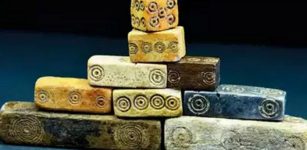 Millennium Old Dice Found In Vadnagar, Gujarat, India
Archaeology | Apr 25, 2022
Millennium Old Dice Found In Vadnagar, Gujarat, India
Archaeology | Apr 25, 2022 -
 Controversial Ancient Takenouchi Documents Could-Re-Write Our History – Story Of Gods, Lost Continents And Ancient Sages
Featured Stories | Apr 28, 2017
Controversial Ancient Takenouchi Documents Could-Re-Write Our History – Story Of Gods, Lost Continents And Ancient Sages
Featured Stories | Apr 28, 2017 -
 Resourceful Pre-Hispanic Society In Bolivia Had Flourishing Agriculture Despite Harsh Environment Of The Andes
Archaeology | Dec 24, 2017
Resourceful Pre-Hispanic Society In Bolivia Had Flourishing Agriculture Despite Harsh Environment Of The Andes
Archaeology | Dec 24, 2017 -
 Has Yorkshire’s Lost Underwater Town Ravenser Odd Finally Been Found?
News | Mar 26, 2022
Has Yorkshire’s Lost Underwater Town Ravenser Odd Finally Been Found?
News | Mar 26, 2022 -
 Yama – Hindu God Who Rules Over The Dead And Souls And Guards Akashic Records
Featured Stories | Sep 17, 2018
Yama – Hindu God Who Rules Over The Dead And Souls And Guards Akashic Records
Featured Stories | Sep 17, 2018 -
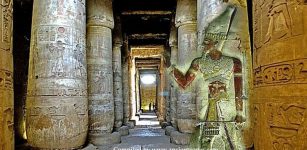 Abydos: One Of The Most Important Cities Of Ancient Egypt
Featured Stories | Jul 15, 2016
Abydos: One Of The Most Important Cities Of Ancient Egypt
Featured Stories | Jul 15, 2016 -
 Evidence Of Dual Mass Extinctions 260 Million Years Ago – Found
Fossils | Apr 10, 2023
Evidence Of Dual Mass Extinctions 260 Million Years Ago – Found
Fossils | Apr 10, 2023 -
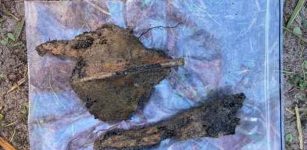 Intrepid Southern Voyage In The Wake Of Early Waka
Archaeology | Jun 28, 2023
Intrepid Southern Voyage In The Wake Of Early Waka
Archaeology | Jun 28, 2023 -
 European Bronze Age Treasure Of Villenna Has Artifacts Made Of Meteoric Iron
Archaeology | Feb 12, 2024
European Bronze Age Treasure Of Villenna Has Artifacts Made Of Meteoric Iron
Archaeology | Feb 12, 2024 -
 Unexpected Discovery Reveals People Arrived In North America 20,000 Years Earlier Than Previously Thought
Archaeology | Jun 5, 2021
Unexpected Discovery Reveals People Arrived In North America 20,000 Years Earlier Than Previously Thought
Archaeology | Jun 5, 2021 -
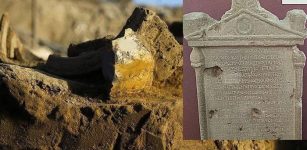 Lost Laodicea Temple And Seleucid Relics – Archaeological Search Continues
Archaeology | Jun 29, 2020
Lost Laodicea Temple And Seleucid Relics – Archaeological Search Continues
Archaeology | Jun 29, 2020 -
 Unexpected discovery of hidden color in ancient mummy portraits
News | Aug 27, 2015
Unexpected discovery of hidden color in ancient mummy portraits
News | Aug 27, 2015 -
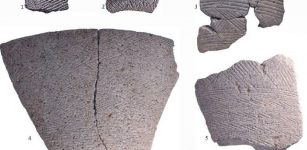 Mysterious Ancient ‘Triangle Code’ And Curious Markings Discovered On Vessels In Israel Reveal Something Interesting
Archaeology | Feb 11, 2019
Mysterious Ancient ‘Triangle Code’ And Curious Markings Discovered On Vessels In Israel Reveal Something Interesting
Archaeology | Feb 11, 2019 -
 How The Great Sphinx Gave Thutmose IV Power To Become Pharaoh
Civilizations | Jul 19, 2021
How The Great Sphinx Gave Thutmose IV Power To Become Pharaoh
Civilizations | Jul 19, 2021 -
 Chagyrskaya Female Neandertal That Lived 60,000-80,000 Years Ago – Studied
Archaeology | Jun 23, 2020
Chagyrskaya Female Neandertal That Lived 60,000-80,000 Years Ago – Studied
Archaeology | Jun 23, 2020 -
 Unsolved Enigma Of The Lost Ancient City In The Kalahari Desert
Civilizations | Aug 29, 2015
Unsolved Enigma Of The Lost Ancient City In The Kalahari Desert
Civilizations | Aug 29, 2015 -
 Joseph Pujol – The Professional Farter Who Entertained People
Featured Stories | Jan 29, 2020
Joseph Pujol – The Professional Farter Who Entertained People
Featured Stories | Jan 29, 2020 -
 Giant 4,500-Year-Old Axe Grinding Site Discovered In Scotland
Archaeology | Dec 13, 2022
Giant 4,500-Year-Old Axe Grinding Site Discovered In Scotland
Archaeology | Dec 13, 2022 -
 3,000-Year-Old Silver Goblet That May Have Belonged To Mannaea Kingdom – Unearthed
Archaeology | Apr 3, 2019
3,000-Year-Old Silver Goblet That May Have Belonged To Mannaea Kingdom – Unearthed
Archaeology | Apr 3, 2019 -
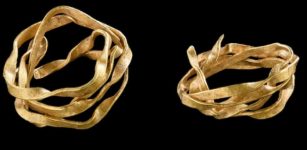 Gold Spiral In Early Bronze Age Grave – Unearthed
Archaeology | Jun 1, 2021
Gold Spiral In Early Bronze Age Grave – Unearthed
Archaeology | Jun 1, 2021

![Tiglath-Pileser III besieging a town named U[pa?], possibly in Turkey.](https://www.ancientpages.com/wp-content/uploads/2019/05/iglathPileser32.jpg)